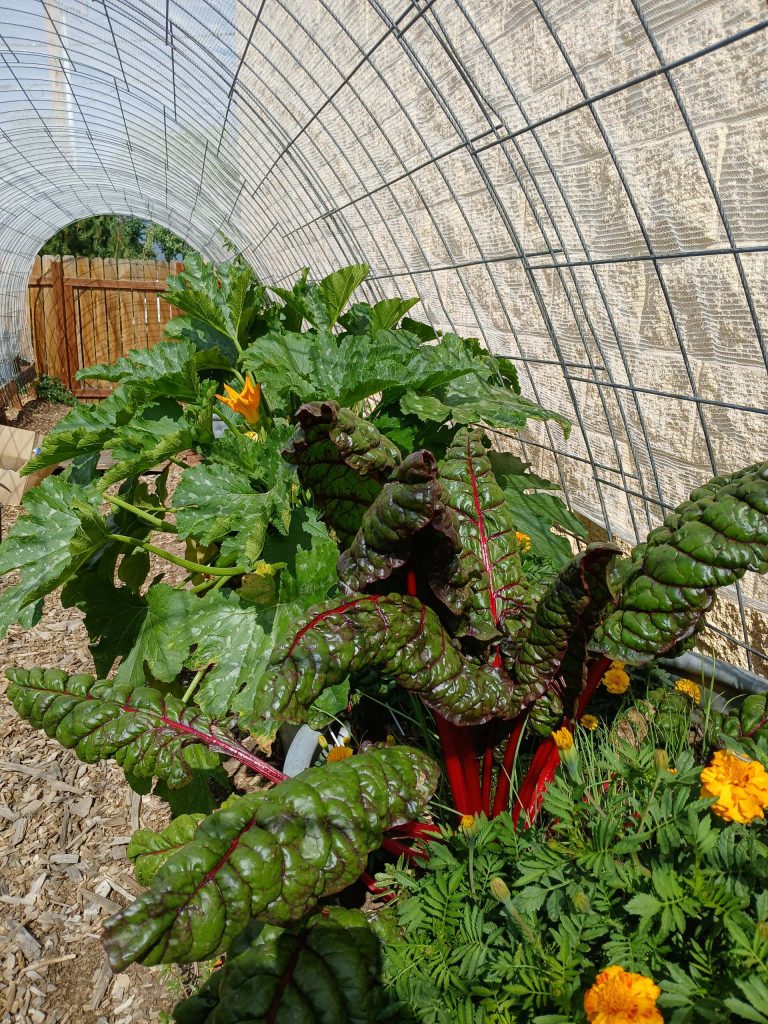By Janet Sellers
Our wood chips that come from local fire mitigation have a number of benefits. The official monikers for chunky wood mulch uses are “Back to Eden” and “permaculture” and use the many sizes of chips, which is key. Many people buy wood chips that are of a uniform size with mediocre benefits, but success with wood chips depends on chunky variable sized chips. The various sizes offer a slow but steady introduction of nutrients and organic materials and lets in moisture and keeps it in, creating a rich soil environment. It supports our growing beds precisely because of the mixed sizes. Some worry about freshly chipped wood mulch as a nitrogen robber. But the mulch stays on top of the soil, and at a safe, 6 inches thick, it kills unwanted grasses and blocks weeds without any digging since it blocks sunlight and yet retains moisture. We can then lift open a planting space in the chips, plant some seeds, put back the chips and seedlings can grow up and out of the soil through the mixed chips.
Mixed chips allow for air pockets gently letting water in and maintain fluffy soil, not a packed soil that happens with irrigation from the top sans mulch protection. There is almost no evaporation, and this mulch keeps consistent optimal temperatures for the soil regardless of hot days or cold nights. It saves on watering, too. Good soil is alive with microbes that depend on such specifics, and protecting it is vital to our plants. The mixed wood chips do that and protect the soil from erosion as well. Are there bugs? No! The chipping process fixes that. Diseases are also not likely and mostly a non-issue. And the best part? We can get a wood chip mulch supply for free through September at Black Forest slash, evenings or weekends. Just check out www. bfslash.org. It’s located at Shoup and Herring Roads, Colorado Springs.
As August begins, our fall seedling efforts start. We can do our brassicas and even beans and lettuces started from seed for a fall harvest. Our hot, dry June and July season was not a normal summer for our climate but may become more common as the years go by. For the last few years, we’ve had hotter temperatures than I remember ever having at our altitude. It fried our grasses this year, but for those of us with wood chips as our “Back to Eden” garden beds, the soil moisture kept up with the heat and we’ve had success with lots of warmth-loving crops. Marigolds and other annual flowers can be started now and enjoyed through the fall. I saved huge bags of marigold seeds from last year’s flowers so I could have a whole landscape of them if planted—what a concept.

Janet Sellers is an avid Back to Eden/permaculture “lazy gardener” letting Mother Nature lead the way for healthy soil and healthy gardens. Send your handy garden tips to JanetSellers@ocn.me.
Other Gardening articles
- High Altitude Nature and Gardens – Wild Horse Fire Brigade: successful fire mitigation since the beginning of…plants (7/31/2025)
- High Altitude Nature and Gardening (HANG) – Gardening with nature’s beautiful bouncers (7/3/2025)
- High Altitude Nature and Gardening (HANG) – Enjoying nature in summer, high altitude landscaping, and weed control (6/7/2025)
- High Altitude Nature and Gardening (HANG) – May: new trees from tree branches, plant partners, bee kind (5/3/2025)
- High Altitude Nature and Gardening (HANG) – Earth Day and the joys of gardening (4/5/2025)
- High Altitude Nature and Gardening (HANG) – Wild outdoors: pine needle bread, gardening in March (3/1/2025)
- High Altitude Nature and Gardening (HANG) – Fermented February, cocoa mulch, and a chocolate “workout” (2/1/2025)
- High Altitude Nature and Gardening (HANG) – January is a seed starter month (1/4/2025)
- High Altitude Nature and Gardening (HANG) – Winter, our backyards, and forests (12/5/2024)
- High Altitude Nature and Gardening (HANG) – Let’s protect our forests, soil, and gardens (11/2/2024)
